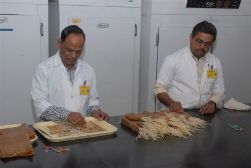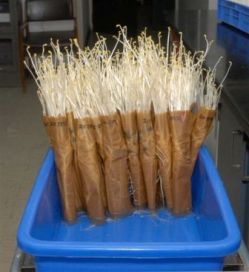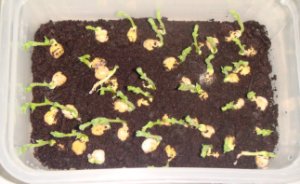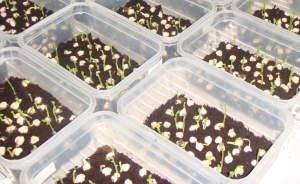Viability of cultivated chickpea and wild relatives genetic resources
Contributors to this page: ICRISAT, Patancheru, India (Hari D Upadhyaya, Shivali Sharma, Cholenahalli L Laxmipathi Gowda, Dintyala Sastry, Sube Singh); NBPGR, New Delhi, India (Shyam Sharma); ICARDA, Aleppo, Syria (Ahmed Amri, Kenneth Street, Natalya Rukhkyan), SARC-RIPP, Piestany, Slovak Republic (Gabriela Antalikova); Institute of Plant Genetic Resources ‘K.Malkov’, Sadovo, Bulgaria (Siyka Stoyanova); Department of Primary Industries, Victoria, Australia (Bob Redden); IPK, Gatersleben, Germany (Andreas Börner).
|
Contents: |
|
|
| Using a sequential viability test on chickpea (photo: ICARDA) |
Laboratory methods
Describes the various recommended options, to test the viability and quality of chickpea seeds. The percentage of germination of the stored seeds of the accessions determines when regeneration of the accessions should take place and if the accession can be distributed to the users.
Type of test
When sufficient seed is available:
- Use a standard viability test (between paper, BP), following the ICRISAT Genebank Manual (Upadhyaya and Laxmipathi, 2009).
When the seed sample is small:
- Use a sequential viability test (following the FAO/IPGRI standards, 1994 and ISTA standards).
Number of seeds and replicates
- Use 50-100 seeds in 2-4 replications (following the ICRISAT Genebank Manual (Upadhyaya and Laxmipathi, 2009); FAO/IPGRI standards, 1994; Normative ISTA and AOSA; ‘Methodics examinations seed and plant, of State variety trials’. Bratislava. 1999. Slovak Republic).
Or
- 10 seeds in 2-4 replications (following the FAO/IPGRI standards, 1994).
Pre-treatment
Follow the recommendations of the ICRISAT Genebank Manual (Upadhyaya and Laxmipathi, 2009):
- Apply a dry seed treatment with fungicide at 3 g/kg seed.
- Scarify the seed coat for hard seeds, especially wild Cicer species.
|
|
| Germinated chickpea seeds using the between paper test (photos: ICRISAT) |
To avoid seed damage resulting from rapid moistening by liquid water in germination substrate, and to improve germination:
- Re-humidify (90% RH) seeds stored in dry and cool environments (-18oC).
- Pre-chill the re-humidified seeds (10oC for 48 hours) followed by germination according to ISTA standards.
Media
Following the recommendations of the ICRISAT Genebank Manual (Upadhyaya and Laxmipathi, 2009):
- Standard paper towel is best and cost effective.
- Alternatively, germination boxes with artificial soil (turf, vermiculate, etc.) using tap water may be used.
Temperature
According to the ICRISAT Genebank Manual (Upadhyaya and Laxmipathi, 2009) and the ISTA Standards:
- 20-25ºC.
Light
According to the ICRISAT Genebank Manual (Upadhyaya and Laxmipathi, 2009):
- Not required.
Duration of test
According to the ICRISAT Genebank Manual (Upadhyaya and Laxmipathi, 2009) and the ISTA Standards:
- 5-10 days after incubation.
Interpretation of results
According to the ICRISAT Genebank Manual (Upadhyaya and Laxmipathi, 2009) and the ISTA Standards (2003, 2005), Association of Official Seed Analysts (AOSA) Standards (2005):
- Scarify hard and ungerminated seeds and evaluate 14 days after incubation.
- If the mean viability percentage of the accession is below 85% (75% for wild species), repeat the test.
- Calculate the mean viability percentage from the results of the two tests and use this as the overall test result.
- If the results are far below the germination standard, the accession should be sent to regeneration.
Monitoring intervals
According to the ICRISAT Genebank Manual (Upadhyaya and Laxmipathi, 2009):
For the active collection (4ºC and 20-30% RH)
- Germination less than 85% - 5 years.
- Germination 85-95% - 8 years.
- Germination 95% or more - 10 years.
For the base collection (-20ºC)
- Germination less than 85% - 10 years.
- Germination 85-95% - 15 years.
- Germination 95% and more - 20 years.
Other option
According to Ellis' and Robert's predictive model with log parameters for initial viability, seed storage temperature and moisture content were used to monitor viability. This was more efficient than routine calendar interval monitoring of viability of collections such as every 5–10 years:
- As per predicted longevity: 20-30 years after initial regeneration and viability testing.
|
Using peatmoth for germination test of Chickpea
Germinated chickpea seeds (photos: ICARDA) |
Recording information during viability testing
The following information must be recorded for each testing step:
- Accession number (unique identification of the accession).
- Taxonomic identification (name).
- Date of storage (date when sample was stored in cold rooms).
- Date of testing (date when sampled was tested for viability).
- Substrate (type of paper used as substratum).
- Temperature [incubation temperature (ºC)].
- Incubation time [incubation period (days)].
- Replications / No. of seeds (number of replications and number of seeds tested).
- Date (date of testing).
- Pre-treatment.
- Days (days from the test date).
- Total germinated [number of seeds germinated in each category (normal, abnormal, non-germinated, hard seeds)].
- Abnormal (number of abnormal seedlings).
- Hard/dormant (number of hard/dormant seeds).
- Dead (number of dead seeds).
-
Germination % (counted on normal seedlings only).
- Seedlings should be judged as normal according to specific criteria - use ISTA Standards (2003, 2005), Association of Official Seed Analysts (AOSA) Standards, (2005).
Routine monitoring
Describes the recommended monitoring methods to assure minimum viability and quantity of seeds in storage.
- Routine inventory management of active collection and base collection using a Genebank Information Management System (GIMS).
- Aim viability of germplasm seed stock at 85% or more, based upon seed age and predicted viability from storage trial (to keep viable seed of all accessions available for distribution, and that seed stock is sufficient for both regeneration and distribution requirements).
- Monitor when seed quantity in active storage falls below 100 g.
- Monitoring – five years in the active collection, ten years in the base collection (recommended in the FAO/IPGRI standards, 1994).
- Use the computerized stock control system to monitor the quality and quantity of seed accessions in the cold store.
Monitoring frequency
Recommends the minimum quantity and minimum viability of seeds below which they need to be regenerated.
Critical quantity
To be detected by data on stocks in the Genebank Information Management System (GIMS) (according to FAO/IPGRI standards, 1994; ISTA Standards).
- For the active collection: critical quantity less than 100 g.
- For the base collection: When the number of seeds falls below the number required for at least three cycles of regeneration.
- For wild Cicer: 300 seeds.
Critical germination level
To be detected by data on stocks in the Genebank Information Management System (GIMS) (according to FAO/IPGRI standards, 1994; ISTA Standards).
- For the active collection: critical germination level less than 75%.
- For the base collection: when viability falls below 85% of the initial value.
- For wild Cicer: critical germination level: less than 75%.
Recording information during storage monitoring
The following information should be recorded for each step:
- Accession identifier/number (unique identifier of the accession).
- Season of crop harvest (mm/yyyy).
- Site of regeneration (place where the samples were regenerated).
- Container (type of container used for storage).
- No. of containers (total number of containers used for storing the sample).
- Date of storage [date on which the sample was stored in the genebank (dd/mm/yyyy)].
- Location in genebank (exact location where the sample is placed in the genebank).
- Seed quantity (g) (quantity of seeds currently available in storage).
- Germination (%) (percentage of seed germination resulting from the recent germination test conducted).
- Date of germination testing [date on which seeds were tested for germination (dd/mm/yyyy)].
- Remarks (any significant observation).
- Active or base storage.
- Age of seed [track age of seed from last regeneration date, or original if seed is from outside sources mostly with unknown storage conditions. This is an indirect guide to viability risk (aim applying predictive model].
- Passport information (follow the Multi-Crop Passport Descriptors, MCPD - Mandatory fields for passport information).
- Seed moisture content (% wet basis).
- Date when accession was sent for regeneration (date, person) [date accessions were sent for regeneration in the field (dd/mm/yyyy)].
- Date of receiving newly regenerated seeds of the accession (date, seed germination, others). According to accepted protocols for seed handling in genebanks.
- Number of regenerations (frequent regeneration can affect germplasm identity).
- Date of next test (one year: if germination % is close to critical value; five years: when it is above 85%).
References and further reading
AOSA (Association of Official Seed Analysts). 2005. In: Rules for Testing Seeds (Capashew Ed.), 4-0, 4-11. Las Cruces, NM. pp.113.
Bratislava. 1999. Methodics examinations seed and plant, of State variety trials. Slovak Republic.
GIMS (Genebank Information Management System) – a standalone facility of ICRISAT Genebank. International Crops Research Institute for the Semi-Arid Tropics, Patancheru, A.P. 502 324, India. In: Manual of Genebank Operations and Procedures - Technical Manual no. 6. International Crops Research Institute for the Semi-Arid Tropics, Patancheru 502 324, Andhra Pradesh, India: ISBN 92-9066-421-5.
FAO/IPGRI. 1994. Genebank standards. Food and Agriculture Organization of the United Nations, Rome and International Plant Genetic Resources Institute, Rome. Available in English, Spanish, French and Arabic.
FAO/IPGRI. 2001. Multi-Crop Passport Descriptors. FAO and IPGRI, Rome, Italy. Available in English, French and Spanish.
ISTA. 1993. International rules for seed testing. International Seed Testing Association. Bassersdorf, Switzerland. Seed Science and Technology 21 (Supplement):1-288.
ISTA. 2003. International rules for seed testing. International Seed Testing Association. Bassersdorf, Switzerland.
ISTA. 2005. International rules for seed testing. International Seed Testing Association. Bassersdorf, Switzerland.
Rao NK, Hanson J, Dulloo ME, Ghosh K, Nowel D, Larinde M. 2006. Manual of seed handling in genebanks. Handbooks for Genebanks No. 8. Bioversity International, Rome, Italy. Available in English (1.5 MB), Spanish (1.4 MB) and French (1.9 MB).
Upadhyaya HD, Laxmipathi Gowda CL. 2009. Managing and Enhancing the Use of Germplasm – Strategies and Methodologies. Technical Manual no. 10. Patancheru 502 324, Andhra Pradesh, India: International Crops Research Institute for the Semi-Arid Tropics. 236 pp.
Comments
- No comments found










Leave your comments
Post comment as a guest